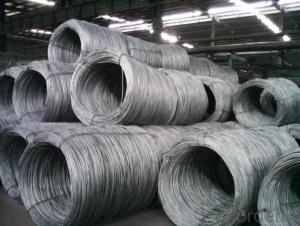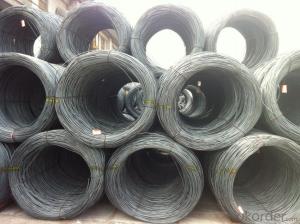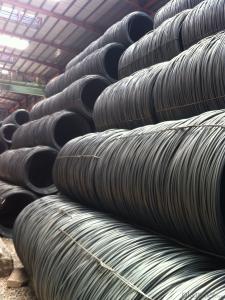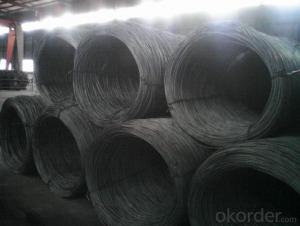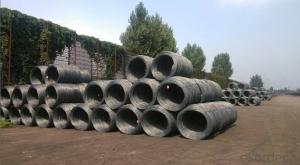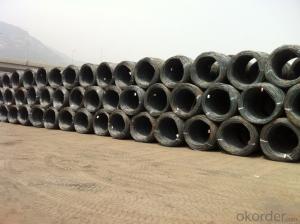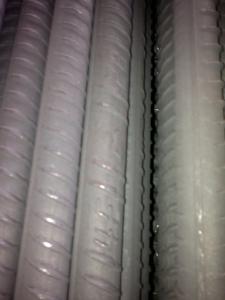Steel Wire Rods Hot Rolled in Low Carbon
- Loading Port:
- China main port
- Payment Terms:
- TT OR LC
- Min Order Qty:
- 100 m.t.
- Supply Capability:
- 10000 m.t./month
OKorder Service Pledge
OKorder Financial Service
You Might Also Like
Product Description:
OKorder is offering Steel Wire Rods Hot Rolled in Low Carbon at great prices with worldwide shipping. Our supplier is a world-class manufacturer of steel, with our products utilized the world over. OKorder annually supplies products to African, South American and Asian markets. We provide quotations within 24 hours of receiving an inquiry and guarantee competitive prices.
Product Applications:
Steel Wire Rods Hot Rolled in Low Carbon are ideal for structural applications and are widely used in construction and manufacturing. Carbon steel wire rod is mainly used for reinforcement of reinforced concrete and welded structure or reprocessed (roberts , nail, etc.) materials, especially used to produce wire drawing, welding electrode, nails, spring, electronic, precise machinery parts and so on.
Product Advantages:
OKorder's Steel Wire Rods Hot Rolled in Low Carbon are durable, strong, and wide variety of sizes.
Main Product Features:
· Premium quality
· Prompt delivery & seaworthy packing (30 days after receiving deposit)
· Can be recycled and reused
· Mill test certification
· Professional Service
· Competitive pricing
Product Specifications:
Steel Grade: SAE1006-1018B
Standard: ASTM, GB
Diameter: 5.5mm, 6.5mm, 7mm,8mm,9mm,10mm,12mm,14mm
Type: in coil, coil weight around 2MT
Alloy or Not: Alloy
Technique: Hot Rolled
Place of Origin: China Mainland
Surface: round, no twisted, light and smooth
Grade | Chemical Composition(%) | |||||
C | Mn | Si | S | P | B | |
SAE1006B | 0.03~O.07 | ≤0.32 | ≤0.30 | ≤0.045 | ≤0.040 | >0.0008 |
Mechanical properties | ||||||
Yield strength(N/mm2) | Tensile strength(N/mm2) | Elongation(%) | ||||
250-280 | 350-380 | ≥32 | ||||
Grade | Chemical Composition(%) | |||||
C | Mn | Si | S | P | B | |
SAE1008B | 0.10max | 0.3~O.50 | 0.15max | 0.050max | 0.040 max | 0.0008 min |
Mechanical properties | ||||||
Yield strength(N/mm2) | Tensile strength(N/mm2) | Elongation(%) | ||||
≥195 | 315-430 | ≥30 | ||||
FAQ:
Q1: How many tons of steel products could be loaded in containers?
A1: Usually the steel products are delivered by bulk vessel because of the large quantity and the freight. However, there are no bulk vessel enter some seaports so that we have to deliver the cargo by containers. The 6m steel product can be loaded in 20FT container, but the quantity is changed according to the size, usually from 18tons to 25tons.
Q2: How do we guarantee the quality of our products?
A2: We have established an advanced quality management system which conducts strict quality tests at every step, from raw materials to the final product. At the same time, we provide extensive follow-up service assurances as required.
Q3: How soon can we receive the product after purchase?
A3: Within three days of placing an order, we will arrange production. The normal sizes with the normal grade can be produced within one month. The specific shipping date is dependent upon international and government factors, the delivery to international main port about 45-60days.
Images:
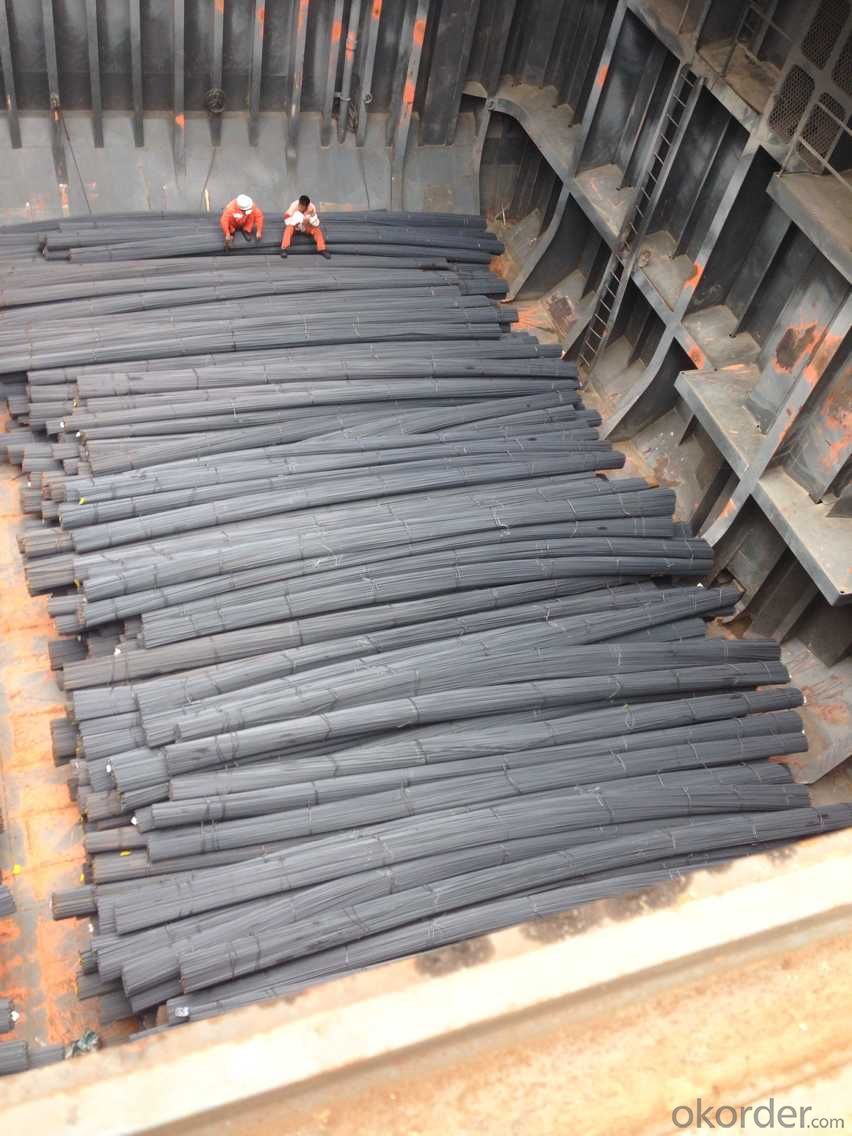
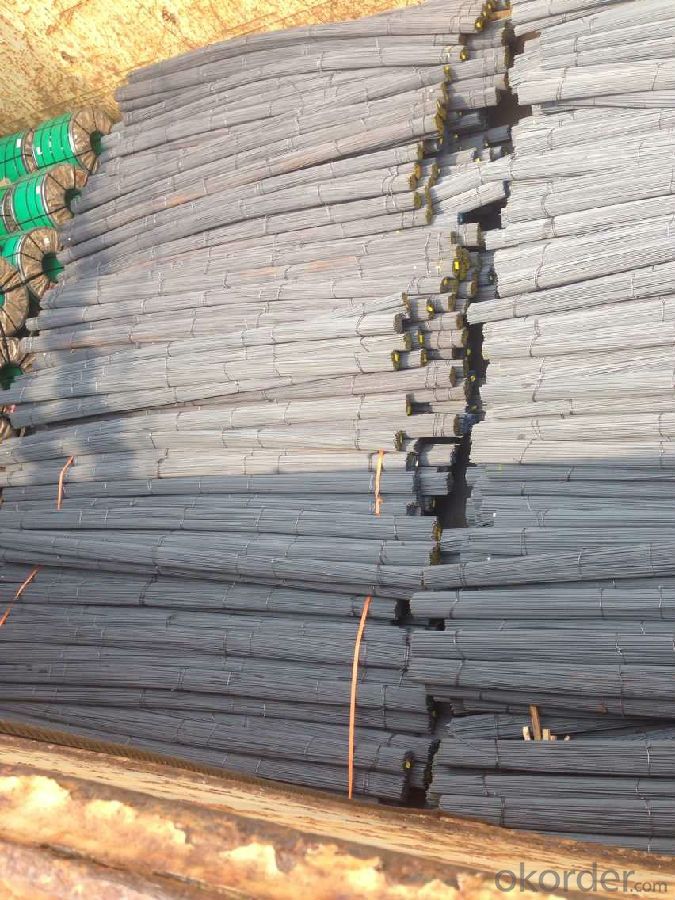
- Q: How is the weldability of steel wire rod evaluated?
- Different techniques and criteria are used to assess the weldability of steel wire rod. An important aspect in evaluating weldability is the chemical composition of the rod. The presence of certain elements, like carbon, sulfur, and phosphorus, can greatly affect how well the material can be welded. The mechanical properties of the wire rod, including tensile strength, ductility, and toughness, are also crucial considerations. These properties can impact the weld joint's quality and integrity. The surface condition of the wire rod is another factor that needs to be evaluated for weldability. Any contaminants or impurities on the surface can have a negative impact on the weldability and lead to defects. Moreover, the welding process and parameters used have a significant role in determining the weldability of the wire rod. Factors like heat input, welding speed, and selection of shielding gas need to be optimized to ensure proper fusion and minimize the risk of defects. Various tests and inspections are conducted to evaluate weldability. This includes visually examining the weld for defects such as cracks, porosity, or incomplete fusion. Non-destructive testing methods like ultrasonic testing or radiography can be used to detect internal flaws or inconsistencies. In addition, mechanical tests like tensile and bend testing are performed to assess the strength and ductility of the weld joint. These tests help determine the overall quality and performance of the welded wire rod. In conclusion, the weldability of steel wire rod is evaluated by considering factors such as chemical composition, mechanical properties, surface condition, welding process, and conducting tests and inspections to ensure the quality and integrity of the weld joint.
- Q: What are the main factors affecting the market partnerships of steel wire rod?
- The main factors affecting the market partnerships of steel wire rod include the demand and supply dynamics of the industry, the competitiveness of the market, the pricing strategies of the competitors, the quality and specifications of the product, the reliability and reputation of the suppliers, the availability and cost of raw materials, the economic and political stability of the countries involved, and the regulatory and trade policies influencing the global steel market.
- Q: How are steel wire rods used in the manufacturing of wire baskets?
- Steel wire rods are an essential component in the manufacturing process of wire baskets. These rods serve as the foundation and structural framework for the baskets. They are typically made from high-quality steel that provides strength, durability, and resistance to corrosion. The first step in using steel wire rods for wire basket manufacturing involves cutting them into the desired lengths. These lengths can vary depending on the size and design of the basket being produced. Once cut, the rods are then shaped into the appropriate form, which can be square, round, or rectangular, depending on the specific requirements of the basket. To create the wire basket, the shaped steel wire rods are interwoven or welded together. This process creates a sturdy mesh-like pattern, forming the body of the basket. The interlocking of the wire rods ensures the basket's structural integrity while allowing for ventilation and visibility. The steel wire rods used in wire basket manufacturing can also be coated or treated to enhance their properties. For example, they can be galvanized to provide a protective layer against rust and corrosion, making the basket suitable for outdoor use or in humid environments. Additionally, the rods can be coated with plastic or vinyl to add color and prevent scratching or damage to the items stored in the basket. Overall, steel wire rods are crucial in the manufacturing of wire baskets as they provide the necessary strength and structure for these versatile storage solutions. Their versatility allows for customization in terms of size, shape, and coating, making wire baskets suitable for a wide range of applications in various industries, including retail, agriculture, and transportation.
- Q: What are the quality control measures for steel wire rod production?
- Quality control measures for steel wire rod production typically include the inspection of raw materials, such as the chemical composition and physical properties of the steel, as well as the monitoring of the manufacturing process, such as checking for defects, surface quality, and dimensional accuracy. Additionally, testing procedures such as tensile strength, hardness, and ductility tests are performed to ensure the quality and reliability of the steel wire rods.
- Q: How is the surface roughness of steel wire rod controlled during manufacturing?
- The surface roughness of steel wire rod is controlled during manufacturing through various processes such as cleaning, descaling, and polishing. These processes remove any impurities, scale, or oxide layers from the surface, resulting in a smoother and more uniform finish. Additionally, the use of specialized rolling mills and techniques helps in achieving the desired surface roughness by controlling the pressure and speed of the rolling process.
- Q: How does the magnetic properties of steel wire rod vary with different heat treatment processes?
- The magnetic properties of steel wire rod can greatly differ depending on the heat treatment processes used. Heat treatment involves subjecting the rod to controlled heating and cooling to change its microstructure, which in turn affects its magnetic properties. One commonly used heat treatment process for steel wire rod is annealing. Annealing involves heating the rod to a specific temperature and then slowly cooling it to room temperature. This process helps relieve internal stresses, refine the grain structure, and enhance the ductility of the wire rod. In terms of magnetic properties, annealing decreases the magnetic permeability of the rod, making it less vulnerable to magnetic fields. This can be advantageous in applications where minimizing magnetic interference is important. Another heat treatment process for steel wire rod is quenching and tempering. Quenching involves rapidly cooling the wire rod from a high temperature to room temperature, usually by immersing it in a quenching medium like oil or water. This rapid cooling results in a hard and brittle structure called martensite. However, martensite is not magnetic and has low ductility. To improve the ductility and toughness of the wire rod, tempering is performed by reheating the quenched wire rod to a lower temperature and then allowing it to cool slowly. The tempering process partially transforms the martensite into a more ductile structure known as tempered martensite. The magnetic properties of the wire rod after quenching and tempering can vary depending on the composition and cooling rate during quenching, as well as the temperature and duration of the tempering process. In conclusion, different heat treatment processes can significantly affect the magnetic properties of steel wire rod. Annealing reduces the magnetic permeability, while quenching and tempering modify the microstructure and magnetic behavior of the rod. The choice of specific heat treatment process depends on the desired magnetic properties and the intended application of the steel wire rod.
- Q: What are the typical applications of steel wire rod?
- Steel wire rod is a versatile material that finds its application in various industries. Some of the typical applications of steel wire rod include: 1. Construction: Steel wire rod is commonly used in construction applications such as reinforcing concrete structures. It provides strength and durability to the construction materials, making them more resistant to cracking and bending. 2. Manufacturing: Steel wire rod is extensively utilized in the manufacturing sector for producing a wide range of products. It is used in the production of nails, screws, springs, cables, ropes, wire mesh, and various other hardware and industrial products. 3. Automotive industry: Steel wire rod is widely used in the automotive industry for manufacturing components like suspension springs, seat springs, wire harnesses, and tire reinforcement. Its high strength and flexibility make it an ideal choice for these applications. 4. Electrical industry: Steel wire rod is used in the electrical industry for producing cables and wires. It provides excellent conductivity and durability, making it suitable for transmitting electric power or signals efficiently. 5. Agriculture: Steel wire rod is utilized in the agricultural sector for various purposes. It is used in fencing, trellis systems, and vineyard wires to provide support and protection to crops and livestock. It is also used in manufacturing agricultural equipment like wire fencing, gates, and animal enclosures. 6. Packaging and fastening: Steel wire rod is employed in the packaging industry for manufacturing wire for packaging purposes, such as baling wire for securing bundles or tying products together. It is also used in fastening applications like wire ties and clips. 7. Furniture and appliances: Steel wire rod is used in the production of furniture and appliances, such as wire shelves, racks, and frames. It provides strength and stability to these products, making them durable and long-lasting. Overall, steel wire rod has a wide range of applications due to its excellent strength, flexibility, and durability. Its versatility makes it an essential material in various industries, contributing to the development and improvement of numerous products and structures.
- Q: How is steel wire rod used in the production of wire mesh for filtration?
- Steel wire rod is an essential component in the production of wire mesh for filtration as it is used to create the individual wires that are woven or welded together to form the mesh. The wire rod is drawn or rolled to the desired diameter, and then it undergoes various processes to ensure its strength and durability. These wires are then woven or welded together in a specific pattern to create the wire mesh, which is widely used in filtration applications to effectively separate solids from liquids or gases.
- Q: What are the different surface coating materials used for steel wire rod?
- Steel wire rods can be enhanced and protected from corrosion by using various surface coating materials. Galvanized wire rods, which are coated with zinc, are widely used due to their excellent corrosion resistance. Epoxy coatings are suitable for wire rods that require protection against chemicals, moisture, and abrasion. Phosphating, on the other hand, involves converting the metal surface into a layer of phosphate crystals to improve adhesion and overall appearance. Polymer coatings, such as PVC or PE, are chosen for their specific properties like electrical insulation or UV resistance. Organic coatings, including paints and lacquers, not only provide aesthetic appeal but also protect against corrosion. The selection of the appropriate coating material for steel wire rods depends on factors such as the intended application, environmental conditions, and desired properties. Manufacturers carefully consider these factors to ensure the wire rod meets the specific requirements of the end product.
- Q: How does the coating affect the performance of steel wire rod?
- The coating on steel wire rod can have a significant impact on its performance. Firstly, the coating provides protection against corrosion, which is crucial for wire rod that is exposed to moisture or harsh environments. This protection ensures that the wire rod maintains its strength and durability over time, reducing the risk of premature failure. Additionally, the coating can improve the lubricity of the wire rod, making it easier to handle and reducing friction during processing. This can result in smoother wire drawing operations, reducing the risk of surface defects or breakages. The coating can also enhance the bonding properties of the wire rod, particularly when it is used for applications such as welding or concrete reinforcement. A well-applied coating can promote better adhesion to other materials, ensuring the wire rod functions effectively in these applications. Furthermore, the coating can provide insulation properties, making the wire rod suitable for electrical or electronic applications. It can prevent the wire rod from conducting electricity, reducing the risk of short circuits or electrical malfunctions. Overall, the coating on steel wire rod plays a crucial role in protecting, enhancing, and optimizing its performance in various applications. It ensures durability, improves handling, enhances bonding properties, and provides insulation as needed. Therefore, selecting the appropriate coating for specific applications is essential to achieve optimal performance and longevity of steel wire rod.
Send your message to us
Steel Wire Rods Hot Rolled in Low Carbon
- Loading Port:
- China main port
- Payment Terms:
- TT OR LC
- Min Order Qty:
- 100 m.t.
- Supply Capability:
- 10000 m.t./month
OKorder Service Pledge
OKorder Financial Service
Similar products
Hot products
Hot Searches
Related keywords
